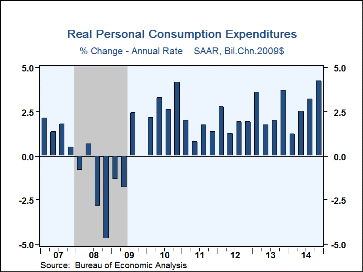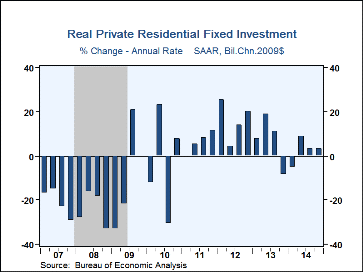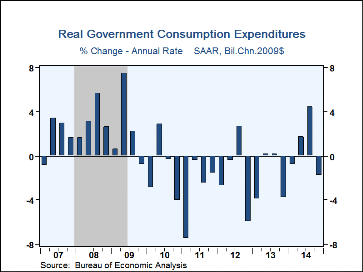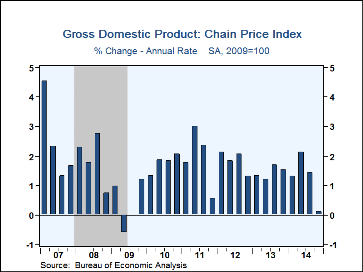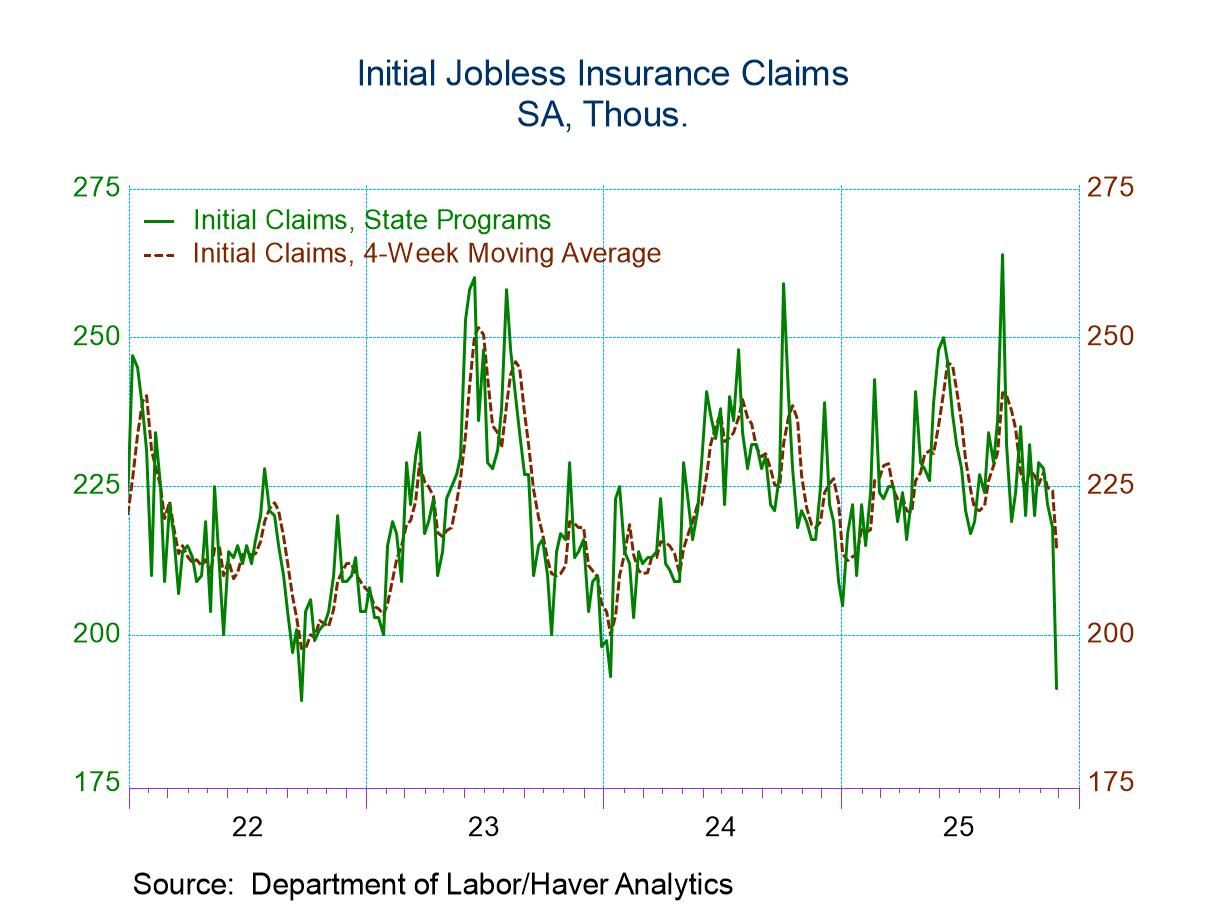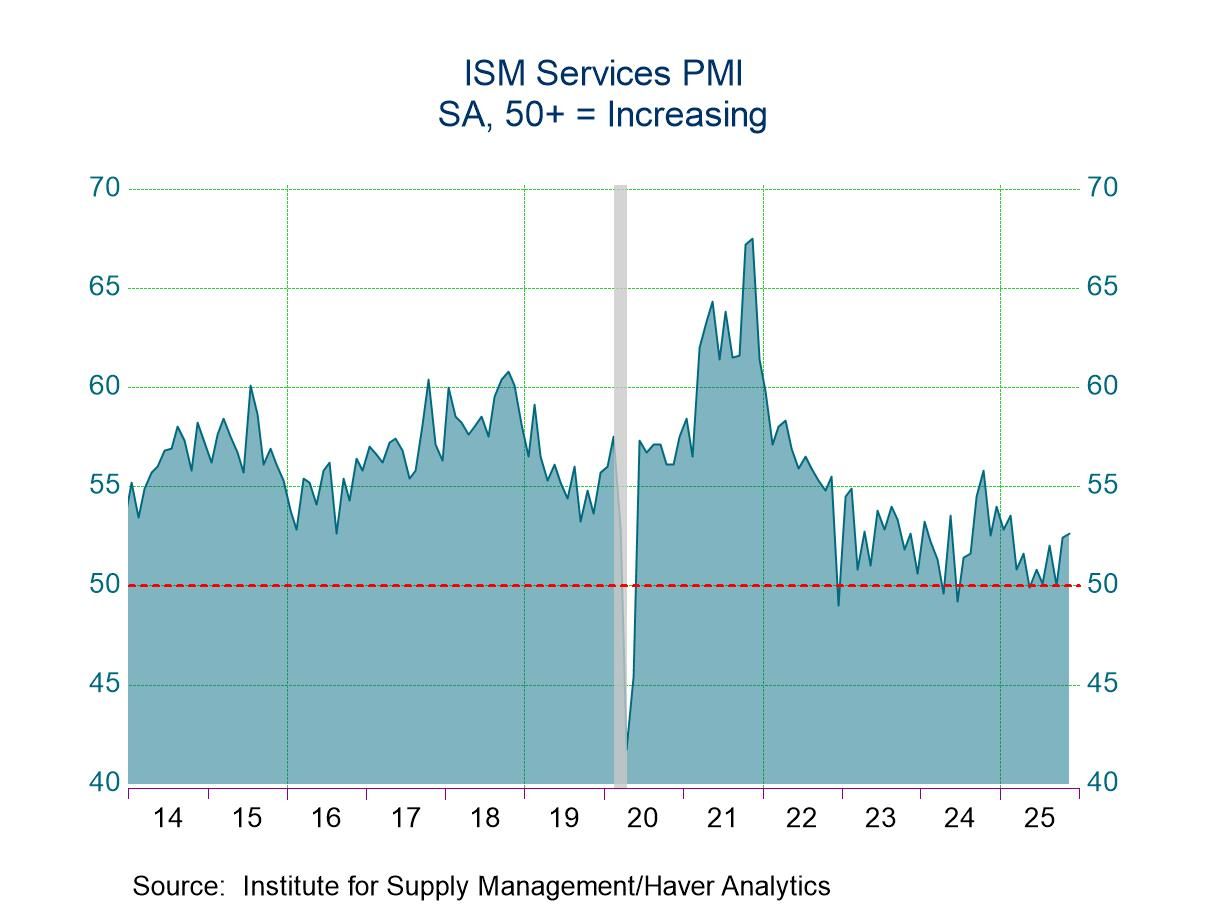 Global| Feb 27 2015
Global| Feb 27 2015U.S. GDP Growth is Revised Lower
by:Tom Moeller
|in:Economy in Brief
Summary
Real GDP growth during Q4 2014 was revised down to 2.2% (2.4% y/y) from the advance estimate of a 2.6% gain. The increase compared to an expected 2.1% rise in the Action Economics Forecast Survey. During all of last year, real GDP [...]
Real GDP growth during Q4 2014 was revised down to 2.2% (2.4% y/y) from the advance estimate of a 2.6% gain. The increase compared to an expected 2.1% rise in the Action Economics Forecast Survey. During all of last year, real GDP expanded 2.4%, up from 2.2% and 2.3% during the prior two years.
A lessened degree of inventory accumulation accounted for much of the revision to last quarter's economic growth. The 0.1 percentage point addition was revised from a 0.8 percentage point addition estimated initially and compared to roughly zero in Q3'14. Deterioration in the foreign trade deficit subtracted an additional 1.2 percentage points from economic growth compared to 1.0 points estimated last month. Exports grew 3.2% (2.1 y/y) while imports jumped 10.1% (5.5% y/y).
Growth in domestic final demand was strengthened to 3.2% (2.8% y/y) from 2.8%. Improved growth in business fixed investment of 4.8% (6.2 y/y), versus 1.9% estimated last month, accounted for the gain. Investment in information processing equipment grew 20.2% (6.9% y/y) but growth in industrial equipment fell 15.0% (+12.0% y/y). Investment in intellectual property products increased 9.1% (7.7% y/y). Business investment accounted for 0.6 percentage points of GDP's increase last quarter. A lessened decline in government spending of 1.8%, versus 2.2% estimated originally, also helped GDP growth. National defense spending fell 12.5% (-0.4% y/y).
The 4.2% increase in consumer spending was little-changed and it added 2.8 percentage points to the GDP advance. Services spending grew 4.1% (2.2% y/y), the largest rise since Q2 2000. Food services paced the advance with a 7.1% increase (4.0% y/y). Spending on durable goods grew 6.0% (8.0% y/y) led by a 9.2% rise (10.3% y/y) in recreational goods & vehicles. Nondurable goods spending rose 3.8% (2.1% y/y), paced by a 9.4% jump (3.0% y/y) in apparel. Purchases at restaurants fell 0.7% (-0.8% y/y), down for the fourth straight quarter. Residential investment spending growth was reduced to 3.3% (2.4% y/y) and it equaled the Q3 increase.
The GDP chain price index edged 0.1% higher (1.2% y/y), little revised from the advance estimate. The personal consumption price index fell 0.4% (+1.1% y/y) but it rose 1.1% (1.4% y/y) excluding food & energy. The business fixed investment price index gained 0.2% (1.0% y/y), held back by a 1.6% decline (+0.3% y/y) in intellectual property product prices. The residential investment price index gained 4.5% (5.2% y/y).
The latest GDP figures can be found in Haver's USECON and USNA databases; USNA contains basically all of the Bureau of Economic Analysis' detail in the national accounts, including the integrated economic accounts and the recently added GDP data for U.S. Territories. The Action Economics consensus estimates can be found in AS1REPNA.
How Should the Fed Interpret Slow Wage Growth? from the Federal Reserve Bank of Richmond is available here.
| Chained 2009 $, %, AR | Q4'14 (Second Estimate) | Q4'14 (Advance Estimate) | Q3'14 | Q2'14 | Q4 Y/Y | 2014 | 2013 | 2012 |
|---|---|---|---|---|---|---|---|---|
| Gross Domestic Product | 2.2 | 2.6 | 5.0 | 4.6 | 2.4 | 2.4 | 2.2 | 2.3 |
| Inventory Effect | 0.1 | 0.8 | -0.0 | 1.4 | 0.1 | 0.1 | 0.0 | 0.1 |
| Final Sales | 2.1 | 1.8 | 5.0 | 3.2 | 2.3 | 2.3 | 2.2 | 2.2 |
| Foreign Trade Effect | -1.2 | -1.0 | 0.8 | -0.3 | -0.5 | -0.1 | 0.3 | 0.1 |
| Domestic Final Sales | 3.2 | 2.8 | 4.1 | 3.4 | 2.8 | 2.4 | 1.9 | 2.1 |
| Demand Components | ||||||||
| Personal Consumption Expenditures | 4.2 | 4.3 | 3.2 | 2.5 | 2.8 | 2.5 | 2.4 | 1.8 |
| Business Fixed Investment | 4.8 | 1.9 | 8.9 | 9.7 | 6.2 | 6.1 | 3.0 | 7.2 |
| Residential Investment | 3.3 | 4.1 | 3.3 | 8.8 | 2.4 | 1.6 | 11.9 | 13.5 |
| Government Spending | -1.8 | -2.2 | 4.4 | 1.7 | 0.9 | -0.2 | -2.0 | -1.4 |
| Chain-Type Price Index | ||||||||
| GDP | 0.1 | -0.0 | 1.4 | 2.1 | 1.2 | 1.5 | 1.5 | 1.8 |
| Personal Consumption Expenditures | -0.4 | -0.5 | 1.2 | 2.3 | 1.1 | 1.3 | 1.2 | 1.8 |
| Less Food/Energy | 1.1 | 1.1 | 1.4 | 2.0 | 1.4 | 1.4 | 1.3 | 1.8 |
Tom Moeller
AuthorMore in Author Profile »Prior to joining Haver Analytics in 2000, Mr. Moeller worked as the Economist at Chancellor Capital Management from 1985 to 1999. There, he developed comprehensive economic forecasts and interpreted economic data for equity and fixed income portfolio managers. Also at Chancellor, Mr. Moeller worked as an equity analyst and was responsible for researching and rating companies in the economically sensitive automobile and housing industries for investment in Chancellor’s equity portfolio. Prior to joining Chancellor, Mr. Moeller was an Economist at Citibank from 1979 to 1984. He also analyzed pricing behavior in the metals industry for the Council on Wage and Price Stability in Washington, D.C. In 1999, Mr. Moeller received the award for most accurate forecast from the Forecasters' Club of New York. From 1990 to 1992 he was President of the New York Association for Business Economists. Mr. Moeller earned an M.B.A. in Finance from Fordham University, where he graduated in 1987. He holds a Bachelor of Arts in Economics from George Washington University.



